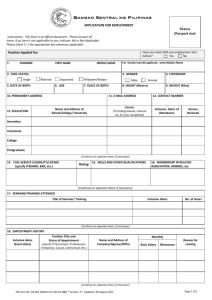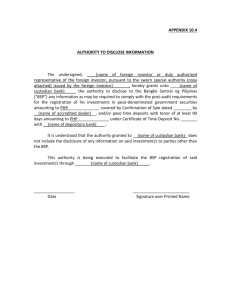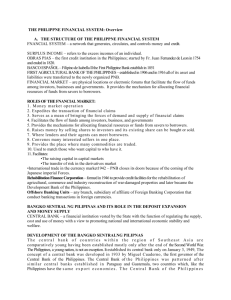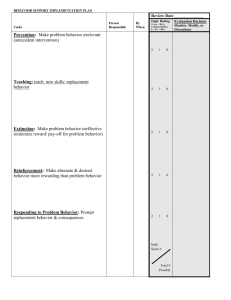Polytechnic University of the Philippines GRADUATE SCHOOL
advertisement
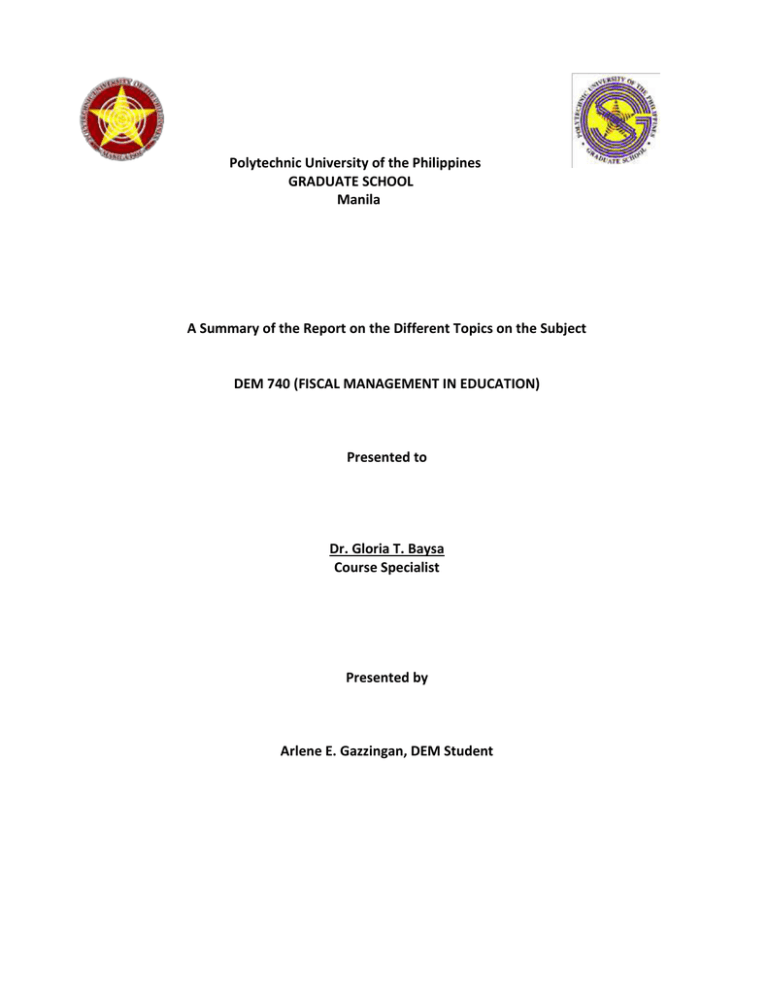
Polytechnic University of the Philippines GRADUATE SCHOOL Manila A Summary of the Report on the Different Topics on the Subject DEM 740 (FISCAL MANAGEMENT IN EDUCATION) Presented to Dr. Gloria T. Baysa Course Specialist Presented by Arlene E. Gazzingan, DEM Student BANGKO SENTRAL NG PILIPINAS (CENTRAL BANK OF THE PHILIPPINES) By JOSEPHINE M. DELA ISLA The Bangko Sentral ng Pilipinas (English: Central Bank of the Philippines; sometimes, Spanish: Banco Central de Filipinas), and commonly abbreviated as BSP on documents written in Filipino or English, is the central bank of the Philippines. It was established on July 3, 1993, pursuant to the provision of Republic Act 7653 or the New Central Bank Act of 1993. Seal of Bangko Sentral ng Pilipinas (1993-2010). The BSP Vision and Mission Vision The BSP aims to be a world-class monetary authority and a catalyst for a globally competitive economy and financial system that delivers a high quality of life for all Filipinos. Mission BSP is committed to promote and maintain price stability and provide proactive leadership in bringing about a strong financial system conducive to a balanced and sustainable growth of the economy. Towards this end, it shall conduct sound monetary policy and effective supervision over financial institutions under its jurisdiction. Functions and Operations Objectives The BSP’s primary objective is to maintain price stability conducive to a balanced and sustainable economic growth. The BSP also aims to promote and preserve monetary stability and the convertibility of the national currency. Responsibilities The BSP provides policy directions in the areas of money, banking and credit. It supervises operations of banks and exercises regulatory powers over non-bank financial institutions with quasi-banking functions. Under the New Central Bank Act, the BSP performs the following functions, all of which relate to its status as the Republic’s central monetary authority. • Liquidity Management. The BSP formulates and implements monetary policy aimed at influencing money supply consistent with its primary objective to maintain price stability. • Currency issue. The BSP has the exclusive power to issue the national currency. All notes and coins issued by the BSP are fully guaranteed by the Government and are considered legal tender for all private and public debts. • Lender of last resort. The BSP extends discounts, loans and advances to banking institutions for liquidity purposes. • Financial Supervision. The BSP supervises banks and exercises regulatory powers over nonbank institutions performing quasi-banking functions. • Management of foreign currency reserves. The BSP seeks to maintain sufficient international reserves to meet any foreseeable net demands for foreign currencies in order to preserve the international stability and convertibility of the Philippine peso. • Determination of exchange rate policy. The BSP determines the exchange rate policy of the Philippines. Currently, the BSP adheres to a market-oriented foreign exchange rate policy such that the role of Bangko Sentral is principally to ensure orderly conditions in the market. • Other activities. The BSP functions as the banker, financial advisor and official depository of the Government, its political subdivisions and instrumentalities and government-owned and controlled corporations. Organization of the Bangko Sentral The basic structure of the Bangko Sentral includes: • The Monetary Board, which exercises the powers and functions of the BSP, such as the conduct of monetary policy and supervision of the financial system; • The Monetary Stability Sector, which takes charge of the formulation and implementation of the BSP's monetary policy, including serving the banking needs of all banks through accepting deposits, servicing withdrawals and extending credit through the rediscounting facility; • The Supervision and Examination Sector, which enforces and monitors compliance to banking laws to promote a sound and healthy banking system; and • The Resource Management Sector, which serves the human, financial and physical resource needs of the BSP The Executive Management Services The BSP Monetary Board Chairman Amando M. Tetangco, Jr. Members Cesar V. Purisima Alfredo C. Antonio Ignacio R. Bunye Peter B. Favila Felipe M. Medalla Armando L. Suratos Position Classification and Compensation Scheme for Teaching Positions in Elementary and Secondary Schools by Nimfa del Rosario The Teachers’ Preparation Pay Schedule (TPPS) The TPPS is the position classification and compensation scheme for teaching positions in elementary and secondary schools. It similarly applies to guidance counselors/coordinators, school librarians who are given teaching loads. Classification and Compensation Scheme for Teaching Positions in Elementary and Secondary Schools Factors for Classification of Positions Academic or educational preparation; Teaching experience including those in private schools; and Extra-curricular activities for professional growth. Academic Preparation Prerequisites Level I, e.g., Teacher I, School Librarian I - Bachelor of Science in Education degree or equivalent; Level II, e.g., Teacher II, Guidance Counselor II - Bachelor of Science in Education degree or equivalent, plus 20 graduate units; and Level III, e.g., Teacher III, School Librarian III, Guidance Counselor III Master’s degree or equivalent. Special Considerations for Teachers Hardship/Special Hardship Allowance Hardship Allowance, as provided under Section 19 of RA No. 4670, is given to all teachers who are assigned to hardship posts whether resident or transient, on regular or temporary status of employment. Special hardship allowance is granted to teachers assigned to handle multigrade classes. The hardship/special hardship allowance shall not exceed 25% of the basic pay of the teacher, and is in lieu of hazard duty pay. One Salary Grade Increase for Retiring Public School Teachers The one salary grade increase shall take effect on the last day of the service of the retiring public school teacher. The salary of the retiring teacher shall be adjusted upward by one salary grade at the same step of his/her previously assigned salary grade. ISSUES IN EDUCATION FINANCE by Vida M. Orajay Public Finance field of economics concerned with how governments raise money, how that money is spent, and the effects of these activities on the economy or society; studies how governments at all levels provide the public with desired services and how they secure financial resources to pay for these services. Why Public Finance is needed? Governments provide public goods—government-financed items and services such as roads, military forces, lighthouses, and street lights. Private citizens would not voluntarily pay for these services, and therefore businesses have no incentive to produce them. Governments redistribute income by collecting taxes from their wealthier citizens to provide resources for their needy ones. The taxes fund programs that help support people with low incomes. Scope of Public Finance Government Revenue Government Expenditures Public Debt Public Debt Management Public Revenue An important source of tax revenue in most industrialized countries is the income or payroll tax, also known as the personal income tax. Income taxes are imposed on labor or activities that generate income, such as wages or salaries. Governments generate some revenue by charging fees for the services they provide, such as entrance fees at national parks or tolls for using a highway. Capital tax includes items or facilities that generate profits, such as factories, business machinery, and real estate. A property tax is a capital tax used by state and local governments. Property taxes are levied on items such as houses or boats. An excise tax is levied on a specific product, such as alcohol, cigarettes, or gasoline. Public Debt Management Is the process of establishing and executing a strategy for managing the government debt in order to: Raise the required amount of funding Achieve its risks and cost objectives Meet any other sovereign debt management goals the government may have set. Government Spending Exhaustive spending refers to purchases made by a government for the production of public goods. For example, to construct a new harbor the government buys and uses resources from the economy, such as labor and raw materials. Transfer spending when government transfers income to people to help them support themselves. Transfers can be one of two kinds: cash or in-kind. Cash transfers are cash payments, such as social security checks and welfare payments. In-kind transfers involve no cash payments but instead transfer goods or services to recipients. Examples of in-kind transfers include food stamp coupons and Medicare. Education Expenditure refers to the current operating expenditures in education, including wages and salaries and excluding capital investments in buildings and equipment Government Assistance to Students DepEd GASTPE (Government Assistance to Students and Teachers in Private Education – DepEd Order No. 11, 2. 2003 CHED StuFAPs (Student Financial Assistance Programs) – CMO No. 56, s. 2012 Financial Statement Analysis contains the information you need to help make the decisions needed in your business. It involves Items in a single year’s financial statement, Comparative Financial Statements in a period of time, Statements with those of other businesses. Methods of Financial Statement Analysis 1. Vertical financial Statement Analysis - each item is expressed as a percentage of significant total. 2. Horizontal Statement Analysis - calculate peso or percentage changes in a financial statement item from one period to the next. 3. Common-Size Statements - shows only percentages and no absolute dollar amounts. 4. Trend Percentages - show changes over time in given financial statement items (can help evaluate financial information of several years) 5. Ratio Analysis – the expression of logical relationships between items in a financial statement of a single period (e.g., percentage relationship between revenue and net income) ARTICLE XI-ACCOUNTABILITY OF PUBLIC OFFICERRS (Philippine Constitution) Sec. 1 – Public office is a public trust. Public officers and employees must at all times be accountable to the people, serve them with utmost responsibility, integrity, loyalty, and efficiency, act with patriotism and justice, and lead modest lives. FINANCIAL FORECASTING Forecasting - is projection, assumption and analysis. Forecasting is based on historical data and educated guesses. If the market changes significantly, historical data and "accumulated wisdom" will be of little use in predicting future events. Forecasting is based on assumptions; always develop a variety of forecasts based on different assumption scenarios, and create contingency plans for each scenario. The longer-term the forecast the more inaccurate it will usually be. Nothing is certain but change − especially over the long term. Qualitative- judgemental, consensus, expert Quantitative – trend analysis, multiple regression The Forecasting Process Marketing (sales estimate), Top Management (policy, strategy), Production (capacity, schedules), Accounting(financial statements, depreciation, taxes) will all lead to the Finance Department which will forecast sales. FORECASTING THE EDUCATIONAL COST • Estimating expenditures on the basis of information derived from the source of finance • Estimating expenditures from the accounts of educational institution • Estimating expenditures based on the units for costing (cost/student, cost/ graduates et.) Considering the Costs Recurring Cost and Capital Cost Other Considerations Personnel Equipment Maintenance and other operating expenses Buildings Site Special projects Salary Compensation and Fringe Benefits of PUP Faculty by Nimfa Del Rosario Manual on Position Classification and Compensation Scheme for Faculty Positions in State Universities and Colleges Prior to the issuance of PD No. 985, State Universities and Colleges (SUCs)which were exempted from the coverage of the National Position Classification and Compensation Plans adopted individual staff credentials and qualifications, position classification and pay plans. As early as 1982, the Philippine Association of State Universities and Colleges (PASUC), together with the DBM, started deliberating on a scheme of upgrading/promoting qualified and deserving faculty members through a process of objective evaluation. This paved the way to the development and adoption of a Common Criteria for Evaluation (CCE) across programs and disciplines which aimed to rationalize academic ranks and salaries. NCC No. 68, NCC No. 69 and the latest, National Budget Circular (NBC) No. 461. NBC No. 461 is a revision and an update of NCC No. 69 which was exclusively for the faculty positions in SUCs. Under NBC No. 461, Commission on Higher Education (CHED)-supervised higher education institutions (HEIs), Technical Education and Skills Development Authority (TESDA)-supervised Technical Education Institutions (TEIs) and SUCs are covered. The Point System The CCE point system in determining faculty rank and sub-rank is as follows: Major Factors and Maximum Points Point Allocation Under NBC No. 461 Qualitative Contribution Evaluation QCE is the process of determining the eligibility of a faculty candidate for the particular rank and sub-rank indicated by the QCE. Qualitative Contribution (QC) is the continuous improve towards excellence by a faculty member in all four (4) functional areas of the institution, namely: instruction, research, extension and production. Point Allocation Under NBC No.461 with QCE Faculty Rank Instructor Assistant Professor Associate Professor Professor College Professor University Professor Sub-Rank I II III I II III IV I II III IV V I II III IV V VI SG 12 13 14 15 16 17 18 19 20 21 22 23 24 25 26 27 28 29 30 31 Point Rank 65-below 66-76 77-87 88-96 97-105 106-114 115-123 124-130 131-137 138-144 145-151 151-158 159-164 165-170 171-176 177-182 183-188 189-194 195-200 201-205 QCE POINTS 80-83 84-85 86-87 88-89 90 91-95 61-65 66-70 71-75 76-80 81-85 86-90 91-95 96-100 Determination of Appropriate Faculty Rank and Salary A faculty member who is assigned on the basis of the CCE and QCE to a sub-rank higher Than his/her present rank, or subsequently promoted through presidential discretion, shall be rank and salary corresponding to that higher rank. A faculty member who merited a higher rank based on the CCE but assigned a lower rank and salary corresponding to that lower rank. In the initial implementation of NBC No. 451, a faculty member who is assigned on the basis of the CCE and QCE to sub-rank lower than his/her present rank shall retain his/her present rank and salary. Role of Agencies in the Implementation of NBC No. 461 Role of SUCs, HEIs and TEIs The heads of SUCs, HEIs and TEIs shall submit the Personal Services Itemization and Plantilla of Personnel (PSIPOP) reflecting the modifications in rank/sub-rank and the corresponding salary adjustments of faculty members concerned together with the CCE Computer Print-Out and pertinent evaluation documents. Role of DBM The DBM Regional Offices ®s) shall verify and post-audit the PSIPOP. The DBM ROS shall then prepare the Notice of Organization, Staffing and Compensation Action (NOSCA) reflecting the changes in the rank/sub-rank and salaries of faculty members concerned in the respective institution. Night Pay of Faculty/Non –Faculty of the Polytechnic University of the Philippines (PUP) The night service is considered as separate and distinct program from the regular 8-hour service. The night pay does not partake of the nature of overtime pay which is not part of basic salary, as a matter of right for recompense of services rendered in the night program of the University. Step Increment of Faculty Members In cases of promotion or movements from one sub-rank to another, the step increment Earned by a faculty member in his/her previous faculty rank cannot be carried over to his/her salary in the higher level faculty rank. His/her next step increment shall be reckoned from the date of his/her appointment to the higher level faculty rank. In case of conversion of a teaching position to a faculty rank, the step increment earned by a teacher in his/her previous position cannot also be carried over to the converted faculty rank. His/her step increment shall be reckoned from the date of his/her appointment to the newly converted faculty rank. PUP Salary And Fringe Benefits SALARY Day Income (Basic Monthly Salary) Part-Time Pay (Teaching) School (Night Monthly Pay) Non-Teaching Overtime/ Temporary Substitution/Graduate School/Open University Pera FRINGE BENEFITS • Rice Alleviation • Clothing Allowance • PIB – Performance Incentive Bonus • PBB – Performance Base Bonus • Anniversary Bonus • Vacation Leave • Sick Leave • Proportional Pay • 13th Month Pay • Merit System Incentive- Distinctive Award with monetary award • Retirement pay – computation is based on the 3 years basic salary and • part-time pay for faculty and for the administrative employee • basic salary and night pay Retirement ELIGIBILITY REQUIREMENTS 1. Member shall be entitled to the retirement benefit, provided he/she is separated from the service at the time of application, and on condition that: 2. Request for conversion from one mode of retirement to another shall not be allowed. 3. The retirement proceeds shall at all times be subject to deduction for any outstanding indebtedness the member may have incurred with the GSIS, subject to existing policies. Money and Economy by Marjerie Quero 1. Monetary Theory • The study of the effect of money in the economy. • Supply of money. • Demand for money. 2. Different Types of Investments Investing in Stocks Stock Market Investing in Bonds Quantity Theory of Money • Supply of money determines the level of prices and changes in the money supply result in proportional changes in prices; • is insensitive to interest-rate movement • Nominal income is determined solely by movements in the quantity of money. Keynes’s Liquidity Preference Theory Motives behind the demand for money: 1. Transactions Motive • Determined by the level of people’s transactions. • These transactions were proportional to income. 2. Precautionary Motive • Cushion against an unexpected need. • The demand for precautionary money balances is proportional to income. 3. Speculative Motive • People hold money as a store of wealth. • Wealth is tied closely to income. Assets to Store Wealth: 1. Money 2. Bonds * Components of the Expected Return: a. Interest Payment b. Expected Rate of Capital Gains Different Types of Investments Investing in Stocks Stock Market Investing in Bonds Overview of the Conceptual Framework of the Course by Sheila Marie L. Jesalva Job Description of Financial Manager • responsible for financial advice • to support the clients and colleagues • responsible for the financial health of an organization Roles of Financial Manager providing and interpreting financial information; monitoring and interpreting cash flows predicting future trends; analyzing change and advising accordingly formulating strategic and long-term business researching and reporting on factors influencing business performance; analyzing competitors and market trends; developing financial management mechanisms that minimize financial risk; managing company's financial accounting, monitoring and reporting systems; liaising with auditors to ensure annual monitoring is carried out; developing external relationships with appropriate contacts producing accurate financial reports to specific deadlines managing budgets; arranging new sources of finance for a company's debt facilities; supervising staff; keeping abreast of changes in financial regulations and legislation. Effectiveness is about doing the right task, completing activities and achieving goals Efficiency is about doing things in an optimal way, for example doing it the fastest or in the least expensive way. It could be the wrong thing, but it was done optimally. Effective and efficient finance manager must: Generate high income in a low expenses Maximize the wealth of the shareholders in a least waste of time and effort Main Factors Affecting Financial Stability and Stability of School -the ability to handle your financial obligations in a way that contributes positively to other areas of your life. Attitude is Essential Goal Setting Resources Leadership Primary Goals of Business 1. Cash flow A growing business needs positive cash flow: - looking at how to get your working capital - combines two tangible facets of business ( what matters & that it flows) 2. Opportunities generate opportunity chains: vision, values and mission > the more right opportunity chains, the faster and more smoothly your business will grow 3. Visibility “ Being seen by somebody is better than nobody is seeing you at all.” > Being recognized as an authority, an expert and a leader To effectively and efficiently manage financial obligations, the finance manager must: plan sound realistic determine the start up cost determine the operating costs running thriving FINANCIAL INTERPRETATION OF RATES AND RATIO by Arlene E. Gazzingan Growth Enrolment Ratio a statistical measure used in the education sector and by the UN in its Education Index to determine the number of students enrolled in school at several different grade levels (like elementary, middle school and high school), and examine it to analyze the ratio of the number of students who live in that country to those who qualify for the particular grade level. For example, if a nation has 900,000 people enrolled in school in the academic year 2005/06, this number is divided by the total number of school-age individuals. Suppose this number is 1,000,000. This means 90 percent of the people are enrolled; or that 90 percent is the Gross Enrollment Ratio of that nation. GER = number of actual students enrolled / number of potential students enrolled Pupil/Student-Teacher Ratio the number of students who attend a school or university divided by the number of teachers in the institution. For example, a student–teacher ratio of 10:1 indicates that there are 10 students for every one teacher. Facilities-Pupil/Student Ratio the number of school facilities (classrooms, textbooks, toilets, laboratory rooms etc.) divided by the total number of enrollees in a particular school or bureau. Recurring Unit Cost Regular cost incurred repeatedly, or for each item produced or each service performed. Thus, We can calculate alternative forms of unit costs of education. These are: (i) Cost per learner (unit cost of education) = Total expenditure Total enrolment (ii) Cost per learner actually attending the school = Total expenditure No. of student attending classes (ii) Cost per successful learner (effective unit costs of learner) = Total expenditure Number of pass-out learners (iii) Cost of education per capita = Total expenditure Total population Ratio of Total Education Expenditures to Total School Budget Public expenditure on education as % of total government expenditure is the total public education expenditure (current and capital) expressed as a percentage of total government expenditure for all sectors in a given financial year. Public education expenditure includes government spending on educational institutions (both public and private), education administration, and subsidies for private entities (students/households and other private entities). Promotion Rate the percentage of pupils/students promoted to the next grade/year level in the following school year. (Reference: UNESCO) Promotion Rate= Promotees × 100 Enrolment Dropout Rate the percentage of pupils who leave school during the year for any reason as well as those who complete the previous grade/year level but fail to enroll in the next grade/year level the following school year. How to Compute: DR= Gr.(X-1) enrolment- (Gr.X enrol.-Gr.Xrepeater) SYN-1 SYN_______ × 100 Gr. (X-1)enrolment DR Gr.III= Gr.2enrolment-Gr. Enrolment-Gr.repeaters) SY 2005-06 SY 2006-07_________× 100 Gr.2 enrolment = 295- (289-7) × 100 295 = 295-282 × 100 295 =0.0440678 × 100=4.40678 DR Gr III= 4.41% Class Size Indicator a measure of the average number of students in any given course in a school or education system, and it is often expressed as a ratio of students to teachers—e.g., 25 to 1, or 25 students for every one teacher. The term class size may also refer to the total number of students in a particular grade level, or “class,” in a school. Cohort Survival Rate the percentage of enrollees at the beginning grade or year in a given school year who reached the final grade or year of the elementary/secondary level. How to compute: CSR= Number of Grade VI pupils Number of Grade I pupils (6 years ago) Cost-Benefit Analysis by Minda DC Eduarte Cost –Benefit Analysis • is a set of practical procedures for guiding public expenditure decisions. • is the implicit or explicit assessment of the benefits and costs (i.e., pros and cons, advantages and disadvantages) associated with a particular choice. • is a technique for assessing the monetary social costs and benefits of a capital investment project over a given time period. Principles of Cost-Benefit Analysis • Appraisal of a project: It is an economic technique for project appraisal, widely used in business as well as government spending projects (for example should a business invest in a new information system) • Incorporates externalities into the equation: It can, if required, include wider social/environmental impacts as well as ‘private’ economic costs and benefits so that externalities are incorporated into the decision process. In this way, CBA can be used to estimate the social welfare effects of an investment Stages in the application process • Identify all costs and benefits • Measure them • Discount them back to common time period • Assess whether benefits>costs • Assess who bears the benefits and costs • Perform sensitivity analysis • Assess whether proposal is worth it Present Value • Project evaluation usually requires comparing costs and benefits from different time periods • Dollars across time periods are not immediately comparable, because of inflation and returns in the market. Valuing Public Benefits and Costs • Recall that the discount rate, benefits, and costs are needed to compute the present value of a project • For private company: – Benefits = revenues received – Costs = firm’s payments for inputs • For public sector, market prices may not reflect social benefits and costs. – Externalities, for example • Several ways of measuring benefits and costs – Market prices – Adjusted market prices – Consumer surplus – Inferences from economic behavior – Valuing intangibles – • • Market prices – In a properly functioning competitive economy, the price of a good simultaneously reflects its marginal social cost of production and its marginal value to consumers. – Ignores market imperfections – Easy to gather Consumer surplus – Public sector projects can be large, and change market prices Keep in mind • • • • • The choice is the alternative selected. The opportunity cost is the alternative not selected, the opportunity given up. Every choice has a cost; there is no such choice as a free choice. Disadvantages are not costs. With every decision, there is only one choice and one cost.
